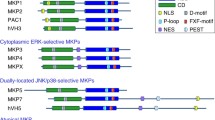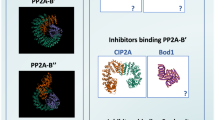Abstract
Both the mitogen-activated protein kinase (MAPK) phosphatases MKP-1 and MKP-2 exert important feedback control of MAPK-mediated signaling events. The function of MKP-1 and MKP-2 is regulated via complex mechanisms, ranging from increased transcription of the MKP-1 and MKP-2 genes to post-translational catalytic activation of MKP-1 and MKP-2 proteins upon binding to their substrate MAPKs. In addition, MKP-1 stability increases upon ERK-dependent phosphorylation of two serine residues in its C-terminus. The C-terminal regions of MKP-1 and MKP-2, but not those of other MKPs, are homologous. To investigate the role of this domain, we have deleted the C-terminal tails from MKP-1 and MKP-2 and examined the effect of these deletions on their enzymatic activity. C-terminally truncated MKP-1 and MKP-2 exhibited, both in vivo and in vitro, substantially greater phosphatase activity towards their substrate MAPKs than did the full-length counterparts. However, C-terminal truncations did not significantly change either their substrate affinity, or their substrate-mediated catalytic activation. Basal phosphatase activity of the truncated proteins was also significantly higher than that of the wild-type counterparts. Collectively, these results suggest that the C-terminal domain may potentially play a role in the regulation of MKP-1 and MKP-2.
Similar content being viewed by others
References
Ahn NG: The MAP kinase cascade. Discovery of a new signal transduction pathway. Mol Cell Biochem 127: 201–209, 1993
Kyriakis JM, Avruch J: Protein kinase cascades activated by stress and inflammatory cytokines. Bioessays 18: 567–577, 1996
Ip YT, Davis RJ: Signal transduction by the c-Jun N-terminal kinase (JNK) - from inflammation to development. Curr Opin Cell Biol 10: 205–219, 1998
Blumer KJ, Johnson GL: Diversity in function and regulation of MAP kinase pathways. Trends Biochem Sci 19: 236–240, 1994
Cobb MH: MAP kinase pathways. Prog Biophys Mol Biol 71: 479–500, 1999
Marshall CJ: MAP kinase kinase kinase, MAP kinase kinase and MAP kinase. Curr Opin Genet Dev 4: 82–89, 1994
Ahn NG, Seger R, Krebs EG: The mitogen-activated protein kinase activator. Curr Opin Cell Biol 4: 992–999, 1992
Keyse SM: Protein phosphatases and the regulation of mitogenactivated protein kinase signalling. Curr Opin Cell Biol 12: 186–192, 2000
Lewis TS, Hunt JB, Aveline LD, Jonscher KR, Louie DF, Yeh JM, Nahreini TS, Resing KA, Ahn NG: Identification of novel MAP kinase pathway signaling targets by functional proteomics and mass spectrometry. Mol Cell 6: 1343–1354, 2000
Davis RJ: The mitogen-activated protein kinase signal transduction pathway. J Biol Chem 268: 14553–14556, 1993
Potapova O, Gorospe M, Bost F, Dean NM, Gaarde WA, Mercola D, Holbrook NJ: c-Jun N-terminal kinase is essential for growth of human T98G glioblastoma cells. J Biol Chem 275: 24767–24775, 2000
Ono K, Han J: The p38 signal transduction pathway: Activation and function. Cell Signal 12: 1–13, 2000
Xia Z, Dickens M, Raingeaud J, Davis RJ, Greenberg ME: Opposing effects of ERK and JNK-p38 MAP kinases on apoptosis. Science 270: 1326–1331, 1995
Bishop JM: Molecular themes in oncogenesis. Cell 64: 235–248, 1991
Hoshino R, Chatani Y, Yamori T, Tsuruo T, Oka H, Yoshida O, Shimada Y, Ari-i S, Wada H, Fujimoto J, Kohno M: Constitutive activation of the 41-/43-kDa mitogen-activated protein kinase signaling pathway in human tumors. Oncogene 18: 813–822, 1999
Hunter T: Protein kinases and phosphatases: The yin and yang of protein phosphorylation and signaling. Cell 80: 225–236, 1995
Camps M, Nichols A, Arkinstall S: Dual specificity phosphatases: A gene family for control of MAP kinase function. FASEB J 14: 6–16, 2000
Charles CH, Abler AS, Lau LF: cDNA sequence of a growth factorinducible immediate early gene and characterization of its encoded protein. Oncogene 7: 187–190, 1992
Keyse SM, Emslie EA: Oxidative stress and heat shock induce a human gene encoding a protein-tyrosine phosphatase. Nature 359: 644–647, 1992
Misra-Press A, Rim CS, Yao H, Roberson MS, Stork PJ: A novel mitogen-activated protein kinase phosphatase. Structure, expression, and regulation. J Biol Chem 270: 14587–14596, 1995
Guan KL, Butch E: Isolation and characterization of a novel dual specific phosphatase, HVH2, which selectively dephosphorylates the mitogen-activated protein kinase. J Biol Chem 270: 7197–7203, 1995
Rohan PJ, Davis P, Moskaluk CA, Kearns M, Krutzsch H, Siebenlist U, Kelly K: PAC-1: a mitogen-induced nuclear protein tyrosine phosphatase. Science 259: 1763–1766, 1993
Ishibashi T, Bottaro DP, Michieli P, Kelley CA, Aaronson SA: A novel dual specificity phosphatase induced by serum stimulation and heat shock. J Biol Chem 269: 29897–29902, 1994
Sun H, Charles CH, Lau LF, Tonks NK: MKP-1 (3CH134), an immediate early gene product, is a dual specificity phosphatase that dephosphorylates MAP kinase in vivo. Cell 75: 487–493, 1993
Noguchi T, Metz R, Chen L, Mattei MG, Carrasco D, Bravo R: Structure, mapping, and expression of erp, a growth factor-inducible gene encoding a nontransmembrane protein tyrosine phosphatase, and effect of ERP on cell growth. Mol Cell Biol 13: 5195–5205, 1993
Groom LA, Sneddon AA, Alessi DR, Dowd S, Keyse SM: Differential regulation of the MAP, SAP and RK/p38 kinases by Pyst1, a novel cytosolic dual-specificity phosphatase. EMBO J 15: 3621–3632, 1996
Muda M, Theodosiou A, Gillieron C, Smith A, Chabert C, Camps M, Boschert U, Rodrigues N, Davies K, Ashworth A, Arkinstall S: The mitogen-activated protein kinase phosphatase-3 N-terminal noncatalytic region is responsible for tight substrate binding and enzymatic specificity. J Biol Chem 273: 9323–9329, 1998
Camps M, Nichols A, Gillieron C, Antonsson B, Muda M, Chabert C, Boschert U, Arkinstall S: Catalytic activation of the phosphatase MKP-3 by ERK2 mitogen-activated protein kinase. Science 280: 1262–1265, 1998
Alessi DR, Smythe C, Keyse SM: The human CL100 gene encodes a Tyr/Thr-protein phosphatase which potently and specifically inactivates MAP kinase and suppresses its activation by oncogenic ras in Xenopus oocyte extracts. Oncogene 8: 2015–2020, 1993
Liu Y, Gorospe M, Yang C, Holbrook NJ: Role of mitogen-activated protein kinase phosphatase during the cellular response to genotoxic stress. Inhibition of c-Jun N-terminal kinase activity and AP-1-dependent gene activation. J Biol Chem 270: 8377–8380, 1995
Raingeaud J, Gupta S, Rogers JS, Dickens M, Han J, Ulevitch RJ, Davis RJ: Pro-inflammatory cytokines and environmental stress cause p38 mitogen-activated protein kinase activation by dual phosphorylation on tyrosine and threonine. J Biol Chem 270: 7420–7426, 1995
Franklin CC, Kraft AS: Conditional expression of the mitogen-activated protein kinase (MAPK) phosphatase MKP-1 preferentially inhibits p38 MAPK and stress-activated protein kinase in U937 cells. J Biol Chem 272: 16917–16923, 1997
Brunet A, Roux D, Lenormand P, Dowd S, Keyse S, Pouyssegur J: Nuclear translocation of p42/p44 mitogen-activated protein kinase is required for growth factor-induced gene expression and cell cycle entry. EMBO J 18: 664–674, 1999
Guo YL, Kang B, Williamson JR: Inhibition of the expression of mitogen-activated protein phosphatase-1 potentiates apoptosis induced by tumor necrosis factor-alpha in rat mesangial cells. J Biol Chem 273: 10362–10366, 1998
Brondello JM, McKenzie FR, Sun H, Tonks NK, Pouyssegur J: Constitutive MAP kinase phosphatase (MKP-1) expression blocks G1 specific gene transcription and S-phase entry in fibroblasts. Oncogene 10: 1895–1904, 1995
Brondello JM, Pouyssegur J, McKenzie FR: Reduced MAP kinase phosphatase-1 degradation after p42/p44MAPK-dependent phosphorylation. Science 286: 2514–2517, 1999
Hutter D, Chen P, Barnes J, Liu Y: Catalytic activation of mitogenactivated protein (MAP) kinase phosphatase-1 by binding to p38 MAP kinase: Critical role of the p38 C-terminal domain in its negative regulation. Biochem J 352: 155–163, 2000
Slack DN, Seternes OM, Gabrielsen M, Keyse SM: Distinct binding determinants for erk2/p38alpha and jnk map kinases mediate catalytic activation and substrate selectivity of map kinase phosphatase-1. J Biol Chem 276: 16491–16500, 2001
Chen P, Hutter D, Yang X, Gorospe M, Davis RJ, Liu Y: Discordance between the binding affinity of mitogen-activated protein kinase subfamily members for MKP-2 and their ability to catalytically activate the phosphatase. J Biol Chem 276: 29440–29449, 2001
Derijard B, Hibi M, Wu IH, Barrett T, Su B, Deng T, Karin M, Davis RJ: JNK1: A protein kinase stimulated by UV light and Ha-Ras that binds and phosphorylates the c-Jun activation domain. Cell 76: 1025–1037, 1994
Jonat C, Rahmsdorf HJ, Park KK, Cato AC, Gebel S, Ponta H, Herrlich P: Antitumor promotion and antiinflammation: Downmodulation of AP-1 (Fos/Jun) activity by glucocorticoid hormone. Cell 62: 1189–1204, 1990
Kyriakis JM, Banerjee P, Nikolakaki E, Dai T, Rubie EA, Ahmad MF, Avruch J, Woodgett JR: The stress-activated protein kinase subfamily of c-Jun kinases. Nature 369: 156–160, 1994
Dowd S, Sneddon AA, Keyse SM: Isolation of the human genes encoding the pyst1 and Pyst2 phosphatases: Characterisation of Pyst2 as a cytosolic dual-specificity MAP kinase phosphatase and its catalytic activation by both MAP and SAP kinases. J Cell Sci 111: 3389–3399, 1998
Li J, Gorospe M, Hutter D, Barnes J, Keyse SM, Liu Y: Transcriptional induction of MKP-1 in response to stress is associated with histone H3 phosphorylation-acetylation. Mol Cell Biol 21: 8213–8224, 2001
Rights and permissions
About this article
Cite this article
Hutter, D., Chen, P., Barnes, J. et al. The carboxyl-terminal domains of MKP-1 and MKP-2 have inhibitory effects on their phosphatase activity. Mol Cell Biochem 233, 107–117 (2002). https://doi.org/10.1023/A:1015502226940
Issue Date:
DOI: https://doi.org/10.1023/A:1015502226940




